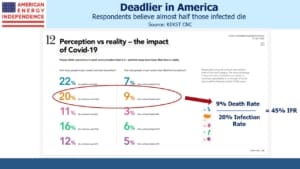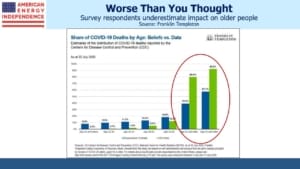Covid Exposes Innumeracy
Labor Day weekend heralds the traditional end of summer in America. School starts shortly thereafter. For the past several months, school districts across the country have been wrestling with modified in-person versus fully online classes.
It’s the most consequential set of decisions of the pandemic. 50 million students attend school from kindergarten through 12th grade. In March, schools abruptly switched to online learning. Few will be surprised that it failed students and piled stress on teachers as well as working parents. Children are collateral damage, “…many students are struggling and falling far behind where they should be” reported the head of the Los Angeles Unified School District (see The Results Are In for Remote Learning: It Didn’t Work).
The effectiveness of lockdowns is increasingly being questioned – New York City’s was imposed by Mayor de Blasio on March 20th, and infections continued rising for another three weeks. Deaths peaked after four weeks. By early May, two thirds of hospital admissions were from people who had been sheltering at home, in compliance with the lockdown.
Moreover, cases continued to fall and have stayed low after some restrictions were eased, suggesting that the spread had reached its break point without government intervention. We may slow infections temporarily, but ultimately the virus moves through the community.
Lockdowns have turned out to be a “blunt and economically costly tool” according to a recent article. Sweden’s modest restrictions were widely criticized, but its fatality rate is lower than the UK, which imposed tougher controls. Sweden’s Nordic neighbors have done better, but that’s partly due to Sweden’s more expansive definition of a Covid death.
The UK is seeing a 40% jump in non-Covid deaths, suggesting people are delaying seeking medical care. The government has pleaded with citizens to “protect” the National Health Service, by not getting sick. We haven’t yet started to count the cost of mitigation.
It turns out there are such enormous gaps between public perception and reality that statistics ought to be a core requirement for a high school diploma.
Two surveys illustrate: one from Kekst CNC polled 1,000 adults in each of five different countries. The average rate of infection estimated by U.S. respondents was 20% — 66 million people, or 20X the number of CDC-confirmed cases at the time. Serology tests that look for the presence of Covid anti-bodies show that the actual infection rate is many times higher than the number of positive tests, so this result might imply the respondents have a more sophisticated understanding.
Their estimate of deaths shows otherwise, with an average response of 9% of the population. If 30 million Americans had died, rather than 180,000, that would suggest an Infection Fatality Rate (IFR) of 45%. Estimates put it at under 0.5% for all ages and perhaps 0.1% for those under 65.
The Covid IFR is tragically high for the older population, those with co-morbidities, and worse if you’re old and have health problems. But here, another survey shows that people underestimate the proportion of deaths inflicted on older age groups. A Franklin Templeton-Gallup survey found that respondents estimated 58% of deaths were among people 55 and older, whereas it’s 92%. It also found that, “The misperception is greater for those who identify as Democrats, and for those who rely more on social media for information.”
Covid has been the top news story almost all year, feeding or fed by these misperceptions depending on your view. There’s no better example of the primacy of fear over facts than Andrew Cuomo’s upcoming book, American Crisis, which promises an inside view of his handling of the pandemic.
Cuomo’s oversight of the nation’s second worst fatality rate (topped only by New Jersey) is less recognized than his sober daily press conferences.
Dispatching infectious but stable patients back to nursing homes to free up hospital beds that were never needed was leadership that led to thousands of avoidable deaths. A skilled communicator of bad news can dodge accountability.
A poor understanding of the figures is about to infect the nation’s schools. Virtual classes are inferior for everyone, but the impact is most severe for younger children. There are over 35 million students in K-8th grade. Their education will likely be compromised. 27 children aged 5-14 have died from Covid. These are all heartbreaking – as are the 2,793 children who have died from non-Covid causes over the same period.
Clearly teachers are more at risk, depending on age and health. A scared teacher won’t teach well, and there are legitimate cases for older teachers and those with compromised health to opt out. But with entire school districts planning for online instruction because of insufficient staff, our collective failure to understand the numbers has millions of young victims.
If you regularly visit The Covid Tracking Report, the Worldometer Coronavirus pages and Covid-19 Data from the CDC, you’ll find most mainstream news media of little use.
Instead, try Twitter where we’ve found some fact-based reporting, including by Alex Berenson, Florian Krammer, Kyle Lamb and a few others hidden behind pseudonyms such as the Ethical Skeptic and el gato malo.
We also found this quarterly letter from David Capital Partners insightful.
The reason stocks continue to march higher is because investors are collectively processing the data and overlooking the popular mood. The gulf between Wall Street and Main Street was never wider.

